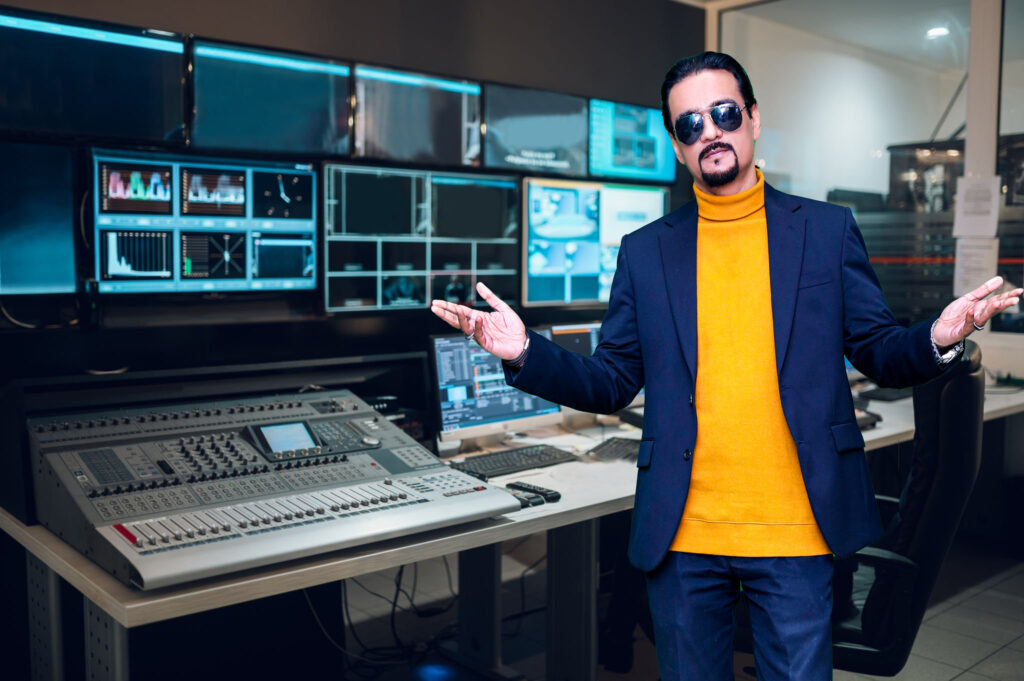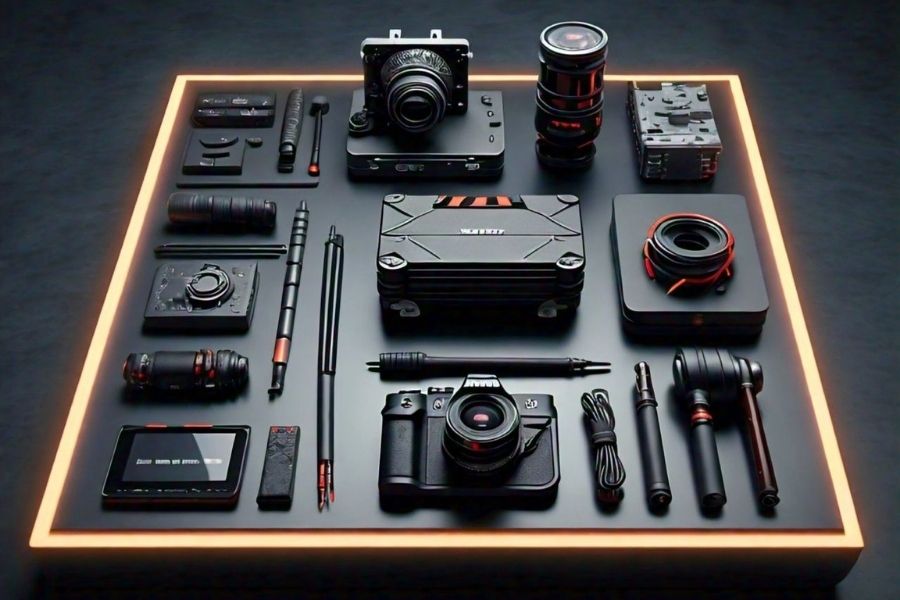Table of Contents
Introduction
Getting into cinematography can be both exciting and overwhelming, especially with the array of equipment available today. Whether you’re a budding filmmaker or a hobbyist wanting to capture high-quality videos, having the right gear is crucial. This guide aims to help you navigate the essentials of cinematography equipment, ensuring you start your journey on the right foot.
1. Cameras as Cinematography Equipment

When it comes to cinematography, the camera is the most critical piece of equipment. The type of camera you choose will significantly impact the quality of your footage and your filming experience.
DSLR Cameras
DSLR (Digital Single-Lens Reflex) cameras have been a popular choice among filmmakers for years. They offer excellent image quality, interchangeable lenses, and full manual control. Models like the Canon EOS Rebel T7i are perfect for beginners due to their user-friendly interface and affordability.
Mirrorless Cameras
Mirrorless cameras are gaining traction due to their compact size and advanced technology. These cameras lack the mirror mechanism found in DSLRs, making them lighter and often faster. The Sony Alpha a6400 is an excellent choice for beginners, offering superb autofocus and 4K video capabilities.
Recommended Models
- Canon EOS Rebel T7i: Great for its intuitive controls and affordability.
- Sony Alpha a6400: Known for its excellent video quality and portability.
- Panasonic Lumix GH5: Ideal for those who want to delve into more professional-level filming with its robust features.
2. Lenses as Cinematography Equipment
Choosing the right lens is as important as selecting the camera. Lenses determine how your camera sees the scene and can dramatically affect the look of your footage.
Prime Lenses
Prime lenses have a fixed focal length, which means they don’t zoom in or out. They typically offer better image quality and wider apertures compared to zoom lenses. The 50mm f/1.8 lens is a fantastic and affordable option for beginners, providing sharp images and beautiful background blur.
Zoom Lenses
Zoom lenses offer versatility, allowing you to change the focal length without swapping lenses. This can be particularly useful for dynamic shooting environments. The 24-70mm f/2.8 lens is a popular choice, balancing versatility and quality.
How to Choose the Right Lens
When starting, it’s essential to have a mix of lenses to cover different scenarios. A 50mm prime lens and a versatile zoom lens like the 24-70mm can cover most of your filming needs.
3. Tripods and Stabilizers as Cinematography Equipment
Stable footage is crucial for professional-looking videos. Shaky footage can distract your audience and diminish the quality of your work.
Tripods
A sturdy tripod is a must-have for any filmmaker. It helps keep your camera steady, especially during long takes or time-lapses. The Manfrotto MT190XPRO4 is a reliable option with its durable build and flexible height adjustments.
Gimbals and Stabilizers
For dynamic shots, gimbals and stabilizers are essential. They help smooth out camera movements, giving your footage a professional polish. The DJI Ronin-S is a popular gimbal that provides excellent stabilization and is user-friendly for beginners.
Best Options for Beginners
- Manfrotto MT190XPRO4: Known for its stability and versatility.
- DJI Ronin-S: Offers great stabilization and is easy to learn.
4. Lighting Equipment as Cinematography Equipment
Good lighting can make or break your film. Understanding and utilizing different types of lighting will enhance the mood and quality of your footage.
Key Lights
The key light is the primary source of light in a scene. It’s usually placed at a 45-degree angle to the subject. The Godox SL-60W is an excellent key light, providing consistent and powerful illumination.
Fill Lights
Fill lights are used to reduce shadows created by the key light. They are usually softer and placed opposite the key light. The Neewer 660 LED Video Light is a great fill light option, offering adjustable brightness and color temperature.
Back lights
help to separate the subject from the background, adding depth to your shot. The Aputure Amaran AL-M9 is a compact and effective back light for beginners.
Lighting Kits for Starters
A basic three-point lighting kit, which includes a key light, fill light, and back light, is perfect for beginners. Kits like the Neewer 3-Pack 660 LED Lighting Kit offer everything you need to get started.
5. Audio Equipment as Cinematography Equipment
Good audio is often more critical than good video. Viewers are more likely to forgive poor visual quality than poor audio quality.
Microphones
External microphones provide much better audio quality than built-in camera microphones. The Rode VideoMic Pro+ is a top choice for beginners, offering clear and crisp sound.
Audio Recorders
An audio recorder like the Zoom H4n Pro can be invaluable for capturing high-quality audio separately from your camera. This is especially useful for interviews and dialogue-heavy scenes.
Importance of Good Audio
Investing in good audio equipment ensures your videos sound professional, enhancing the overall viewer experience. Remember, bad audio can turn viewers away, no matter how good your visuals are.
6. Editing Software as Cinematography Equipment

After shooting, the next step is editing. Good editing software can transform raw footage into a polished final product.
Free Software
For beginners, starting with free software like DaVinci Resolve or HitFilm Express can be a great way to learn the basics without financial investment.
Paid Software
As you progress, you might want to invest in professional editing software like Adobe Premiere Pro or Final Cut Pro X. These programs offer more advanced features and greater flexibility.
Essential Features to Look For
Look for software that offers a user-friendly interface, multi-track editing, and a variety of effects and transitions. This will allow you to edit more efficiently and creatively.
7. External Monitors as Cinematography Equipment
External monitors provide a larger and often more accurate display than your camera’s built-in screen, making it easier to frame and focus your shots.
Benefits of Using External Monitors
They offer better color accuracy, higher resolution, and can display helpful information like focus peaking and exposure zebras. This helps ensure you capture the best possible footage.
Recommended Models
- Feelworld FW568: A budget-friendly option with great features.
- Atomos Ninja V: Offers advanced capabilities like recording in ProRes and HDR.
8. Memory and Storage as Cinematography Equipment
Capturing high-quality video requires substantial storage. Having reliable memory and backup solutions is crucial.
Memory Cards
Invest in high-speed memory cards to ensure smooth recording and playback. The SanDisk Extreme Pro series is known for its reliability and speed.
External Hard Drives
External hard drives are essential for storing and backing up your footage. The Seagate Backup Plus Portable Drive offers a good balance of speed, capacity, and price.
Backup Solutions
Regularly back up your footage to avoid losing valuable work. Consider using both physical and cloud-based solutions for extra security.
9. Drones as Cinematography Equipment
Drones add an exciting dimension to your cinematography, allowing for stunning aerial shots.
Entry-Level Drones
For beginners, drones like the DJI Mini 2 are perfect. They are easy to fly and offer excellent video quality.
Advanced Drones
As you gain experience, you might want to explore more advanced options like the DJI Mavic Air 2, which offers superior camera capabilities and flight performance.
Legal Considerations
Always be aware of the regulations regarding drone usage in your area. Register your drone if required and follow local laws to ensure safe and legal flying.
10. Camera Bags and Cases as Cinematography Equipment
Protecting your gear is crucial. A good camera bag or case keeps your equipment safe and organized.
Features to Look For
Look for bags with padded compartments, weather resistance, and enough space to carry all your essentials. Comfort and accessibility are also key factors.
Recommended Brands
- Lowepro: Known for durable and functional camera bags.
- Pelican: Offers hard cases that provide excellent protection for your gear.
Conclusion
Starting your journey in cinematography is an exciting adventure. With the right equipment, you can create stunning videos and develop your skills as a filmmaker. Remember, the gear is only a tool; your creativity and vision are what truly make your films unique. Happy filming!
FAQs
1. What is the most important piece of cinematography equipment?
The camera is arguably the most crucial piece of equipment, as it directly affects the quality and style of your footage. However, good audio and lighting equipment are also essential.
2. How much should I spend on beginner cinematography equipment?
It depends on your budget, but a good starting point is around $1,500 to $3,000. This should cover a decent camera, a couple of lenses, basic lighting, and audio equipment.
3. Can I start with just a smartphone?
Yes, smartphones today have excellent cameras and can be a great way to start learning the basics of cinematography. Invest in some accessories like a tripod and external microphone to improve your footage.
4. What is the best editing software for beginners?
DaVinci Resolve is a fantastic free option for beginners, offering professional-grade features. As you advance, you might consider paid options like Adobe Premiere Pro or Final Cut Pro X.
5. How do I improve my cinematography skills?
Practice regularly, watch films critically, learn from online tutorials, and seek feedback from more experienced filmmakers. Experiment with different techniques and equipment to find your unique style.

